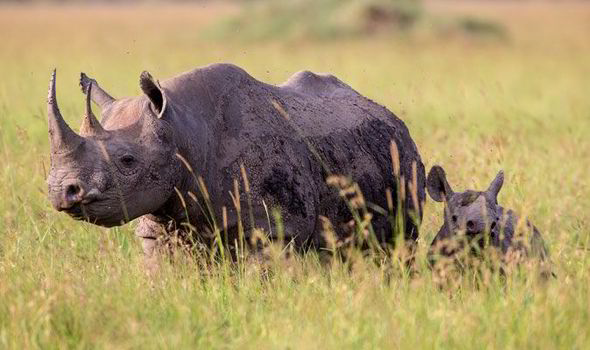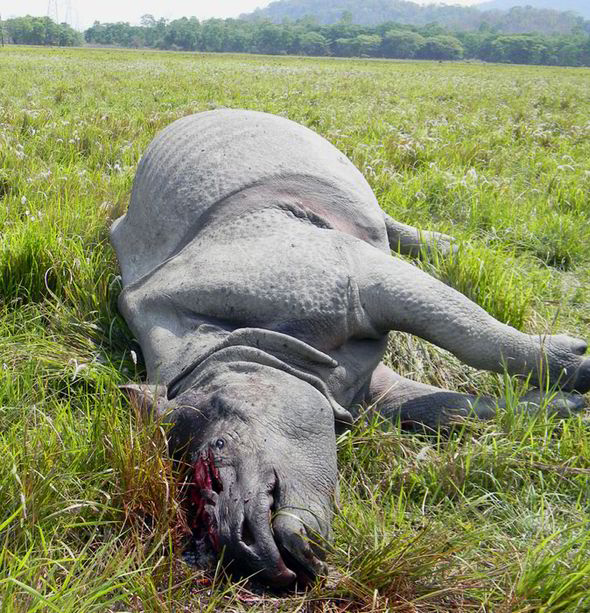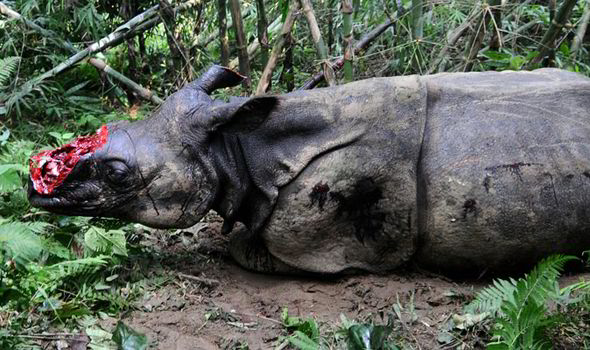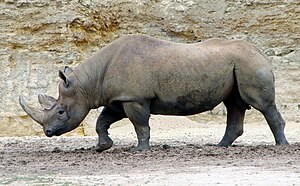what i learned about black rhinos
he black rhinoceros (Diceros bicornis) is the most well known
of the five living rhinoceros species, with its aggressive reputation
and highly publicised international conservation drive. Black rhinoceros
are in fact grey in colour and are distinguished from the other African
species (which is also grey) the white rhinoceros (Ceratotherium simum), by its pointed, prehensile upper lip; white rhinoceros have square lips (2).
Both African rhinoceros species possess two horns, made from clumped
fibres rather than bone, and the taller front horn may be 60 centimetres
or longer
Once found throughout much of sub-Saharan Africa with the exception of
the Congo Basin and other equatorial forest areas of West Africa (4).
The recent decimation of the black rhinoceros has restricted the range
to fragmented populations, predominately existing in reserves in Kenya,
Tanzania, Namibia, Zimbabwe, South Africa, Cameroon, Malawi and
Swaziland (4). Four subspecies are recognised in different areas of the species range: the southwestern (Diceros bicornis bicornis), western (D. b. longipes), eastern (D. b. michaeli) and south-central black rhinoceros (D. b. minor) respectively
 CRITICALLY
CRITICALLY
ENDANGERED
Top facts
- The black rhino has two horns which are made of keratin
- In spite of its name, the black rhino is actually grey
Learn more in our fact file below
Black rhinoceros fact file
Black rhinoceros description
The black rhinoceros
(Diceros bicornis) is
the most well known of the five living rhinoceros species, with its
aggressive reputation and highly publicised international conservation
drive. Black rhinoceros are in fact grey in colour and are distinguished
from the other African species (which is also grey) the white
rhinoceros (
Ceratotherium simum), by its pointed,
prehensile upper lip; white rhinoceros have square lips
(2).
Both African rhinoceros species possess two horns, made from clumped
fibres rather than bone, and the taller front horn may be 60 centimetres
or longer
(4).
- French
- Rhinocéros Noir.
- Spanish
- Rinoceronte Negro.
- Size
- Shoulder height: 1.4 - 1.8 m (2)
- Length: 3 - 3.75 m (2)
- Weight
- 800 - 1400 kg (2)
Top
Black rhinoceros biology
Black rhinoceros conservation
The population crash in the latter half of the 20th Century saw rhinoceros numbers plummet to a low of about 2,400 individuals
(4).
A variety of conservation approaches have been adopted, which have
resulted in the stabilisation and partial recovery of populations in a
number of countries. The most successful have involved the rigorous
protection of rhinoceros in fenced sanctuaries, often in partnerships
between the State and private sectors, or in intensely protected
unfenced zones within larger areas
(4). Dehorning has also been used in some countries to reduce the incentives to poach
(4).
In 1997, Yemen became a signatory of the Convention on International
Trade in Endangered Species (CITES), thus greatly reducing the demand
for rhinoceros horn in the Middle East
(7).
By 2001, the continental black rhinoceros population had increased to
3,100, with populations in six of the eight range states increasing
(4).
Most individuals are conserved in heavily protected areas. The African
Rhino Specialist Group of the World Conservation Union (IUCN) provides
advice on the conservation of African rhinoceros, and has developed a
detailed Action Plan, which provides extensive information and strategic
direction for their conservation









































































